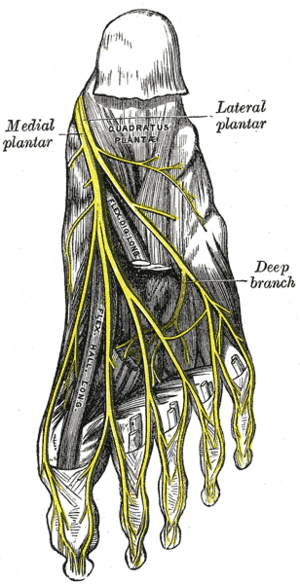Morton's neuroma
| Morton's neuroma | |
|---|---|
 |
|
| The plantar nerves. | |
| Classification and external resources | |
| Specialty | neurology |
| ICD-10 | G57.6 |
| ICD-9-CM | 355.6 |
| DiseasesDB | 8356 |
| MedlinePlus | 007286 |
| eMedicine | orthoped/623 pmr/81 radio/882 |
Morton's neuroma (also known as Morton neuroma, Morton's metatarsalgia, Intermetatarsal neuroma and Intermetatarsal space neuroma.) is a benign neuroma of an intermetatarsal plantar nerve, most commonly of the second and third intermetatarsal spaces (between 2nd−3rd and 3rd−4th metatarsal heads), which results in the entrapment of the affected nerve. The main symptoms are pain and/or numbness, sometimes relieved by removing narrow or high-heeled footwear. Sometimes symptoms are relieved by wearing non-constricting footwear.
Some sources claim that entrapment of the plantar nerve because of compression between the metatarsal heads, as originally proposed by Morton, is highly unlikely, because the plantar nerve is on the plantar side of the transverse metatarsal ligament and thus does not come in contact with the metatarsal heads. It is more likely that the transverse metatarsal ligament is the cause of the entrapment.
Despite the name, the condition was first correctly described by a chiropodist named Durlacher, and although it is labeled a "neuroma", many sources do not consider it a true tumor, but rather a perineural fibroma (fibrous tissue formation around nerve tissue).
Symptoms include: pain on weight bearing, frequently after only a short time. The nature of the pain varies widely among individuals. Some people experience shooting pain affecting the contiguous halves of two toes. Others describe a feeling like having a pebble in their shoe or walking on razor blades. Burning, numbness, and paresthesia may also be experienced. The symptoms progress over time, often beginning as a tingling sensation in the ball of the foot.
Morton's neuroma lesions have been found using MRI in patients without symptoms.
Negative signs include no obvious deformities, erythema, signs of inflammation, or limitation of movement. Direct pressure between the metatarsal heads will replicate the symptoms, as will compression of the forefoot between the finger and thumb so as to compress the transverse arch of the foot. This is referred to as Mulder’s Sign.
...
Wikipedia
